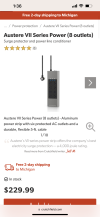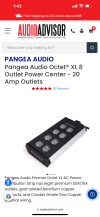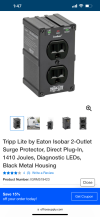Jeff M.
Active Member
- Joined
- Dec 30, 2023
- Messages
- 110
- Likes
- 47
Good Afternoon Everyone. So I am looking into a few power strip companys. I saw this one and it looked reasonably priced. I think the most I would spend on something like this is $500.00 and below. I believe product can only do so much at a certain price point and if you go beyond that it’s just hype. So looking into 3 different brands or Companys and wanted to know if anyone has used or tried them? The first brand is Austere v2 8 is only $229.00 for their top of the line power strip and conditioner. The Second one is from Amazon the brand is Called Viborg and is $349.9@ for their 8 plug power strip and conditioner. I bought 2 set of binding post from them 4 years ago and they are holding up well. No discolored cooper or turing black or green (unlike some brands). The 3rd brand is the Pangea power strip conditioner and it’s $499.99 for their top of the line one. (An update The Pangea is on sale now and is now a $100.00 off so the sale price is $399.99). I did buy the smaller tripp lite power protection for my refrigerator and my router and next will be my stove and then my washer and dryer. So No issues after a power surge or loose of power the last 2 years. I’m just looking for something that is more built for my components and not my appliances . All these brands have Diy wire or already finished valves you can buy. So Am having more and more power outages and brown outs in my area now so I want to be safe. Thanks for anyone advice and suggestions. Be safe. Jeff
Here are some pictures of the 3 products am looking at? and cost and the tripp lite I bought for my appliances. I did buy them on sale for $24.00 each.
Here are some pictures of the 3 products am looking at? and cost and the tripp lite I bought for my appliances. I did buy them on sale for $24.00 each.
Attachments
Last edited:



